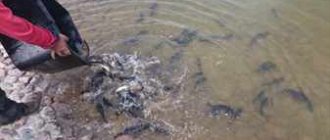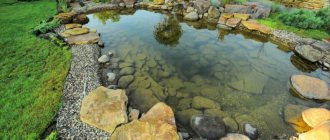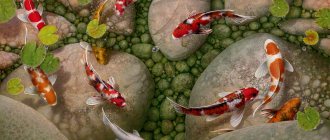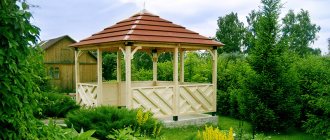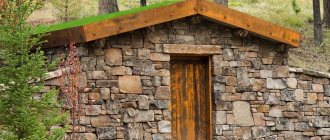From this article you will learn:
- What kind of pond can be built
- Where to start building a pond
- What kind of waterproofing is needed during pond construction?
- What are the stages of constructing a pond?
- How much does it cost to build a pond
Even if you are not one of the lucky owners of summer cottages located on the shore of a reservoir, this is not a reason to despair. Modern technologies and materials allow you to build a pond yourself; all you need is the desire and the necessary funds. Despite all the laborious, troublesome and costly process, the result is worth it. You will learn about what type of pond can be built, what kind of waterproofing is needed, as well as how to properly care for this structure in this article.
Where to start building a pond
- Conditions.
It is worth knowing that the microclimate and ecology of the area depend on both natural and artificial reservoirs.
Quite often situations may arise in which the construction of a pond at the dacha will be impossible or extremely problematic.
When you decide to build an artificial pond on your summer cottage, check whether the following conditions necessary for this can be met:
- The area of the site should be large enough in size and also have a relatively flat surface. It is strictly not recommended to place a pond in the immediate vicinity of the house and in lowlands (otherwise all rainwater, etc., will flow into it).
- The surface of the reservoir should be illuminated by direct sunlight for no more than 4–6 hours a day. Otherwise, water blooms may occur. If there is no such place on your summer cottage, it can be created artificially, for example, by planting trees and shrubs.
- If you want to place the pond in the shade, you still shouldn’t build it in close proximity to trees. This will lead to the fact that in the fall all the leaves, falling, will fall into the water, which in turn can cause it to clog and rot. In addition, when the root system grows, it can have a negative impact on the banks of the pond.
- The depth of the reservoir should be such as to prevent it from completely freezing in winter (one meter or more).
- Artificial reservoirs can have any irregular shape, completely arbitrary outline. When starting to build a pond, keep in mind that the long side should not be too elongated.
- Having decided on the location of the future reservoir, perform an analysis of the soil composition, determine the places where communications can pass, etc.
- Keep in mind that the price of constructing a pond will be quite high; land management work alone will already cost you a tidy sum.
- Style.
When building a pond, it would be useful to think through the nuances due to which the reservoir will fit into the existing landscape of the site and will correspond to its style. In this case, it is necessary to focus on the architectural design of the country house, as well as the existing layout of the garden. You can additionally arrange a decorative stream or waterfall, design the coastline, and make paths in the same style with the landscape design of the entire site.
For a landscape pond with a natural outline, the best location will be deep in the garden - near the gazebo or not far from the terrace of the house. In this case, you can always sit comfortably and admire the surface of the water.
When choosing a pond design, proceed from your own preferences. You can use Japanese restraint, which involves the use of only boulders of different sizes and coniferous shrubs, without bright multi-colored herbs. Or you can turn to the Chinese style - more lush and bright, attracting attention with an accent tree with variegated leaves and a curved bridge.
Recommended articles to read:
- Awnings for terraces: convenient, compact, original and profitable
- Waterproofing a pool from the inside with film - 10 tips from professionals
- Relaxation tent: types and selection criteria
You can arrange a landscape pond in the “nature garden” style; in this case, the pond is decorated exclusively with local plants growing in the region; any exotic vegetation is not welcome in this design style.
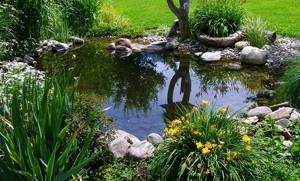
If you are considering building a formal pond with a geometric shape - square or rectangular - then it will look great near the house, while emphasizing its vertical and horizontal lines. Such a pond can be a good addition to a patio or patio, especially if there are rectilinear flower beds or linear paths located nearby.

Among the interesting techniques used in modern landscape design, one can note the laying of paths lined with terrace boards, which span bridges over an artificial reservoir of a broken geometric shape. For this design, concrete paths or individual square slabs can be used, as if floating above the water. An original solution could be cascades of small ponds of various shapes, connected to each other by small waterfalls.
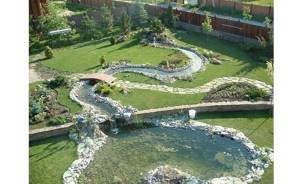
Both round and rectangular ponds are considered formal ponds, used to decorate lawns or open lawns, stylistically complementing a garden area with a pergola or located next to a picturesque group of trees. It is much easier to make small round ponds yourself than any other shape. To do this, you can use ready-made concrete rings, wooden tubs, plastic containers and even car tires.
Distinctive features
To better understand what a pond is, it is worth getting acquainted with its characteristics, which have its own distinctive features:
- The average water surface area of a pond is no more than 1 km².
- The erosion-resistant bottom bed has a gentle slope, while the banks are allowed to be relatively steep.
- If the pond does not have ground recharge, then in winter it may freeze completely, and in the hot season it may dry out.
- At the pond, the water level is allowed to fluctuate greatly depending on the prevailing weather (the level decreases during persistently hot weather, and the level increases after a lot of rain).
- The entire water area of the pond has the same water composition, the same vegetation and fauna.

Waterproofing in pond construction
Having decided to build a pond on your summer cottage, you undoubtedly want it to fit organically into the existing landscape, without demonstrating the efforts spent on its arrangement. This is quite possible, just use the soft design of an artificial reservoir. However, in any case, you will not be able to do without a special film called soft waterproofing.
However, talking about just a film for waterproofing is not entirely correct. There are different types of waterproofers, each of which has its own characteristics.
Polyethylene film used for waterproofing when creating an artificial pond. This material is the cheapest, but at the same time the most fragile and short-lived. The temperature regime for using polyethylene varies from + 60 to -50 ° C. The optimal thickness of the material is considered to be 0.5–1.0 mm; a sufficiently high density, absence of perforation, and, in some cases, the presence of a reinforcing layer are important for it. The service life of this type of waterproofing material is no more than 3 years.

Among the advantages of polyethylene film one can note its relatively low cost, light weight, resistance to rotting, and bioinertness. It can be replaced if damage to the pond occurs, and its individual parts can be easily connected by welding.
The main disadvantages are the short service life, as well as the effect on water turbidity and blooming.
The abbreviation PVC is used to denote an economical material called polyvinyl chloride. The thickness of the PVC film is one millimeter. Due to the possibilities of hermetic gluing or welding, this material can be used to waterproof even large ponds. As for the service life of PVC, it is quite long - up to 15 years.
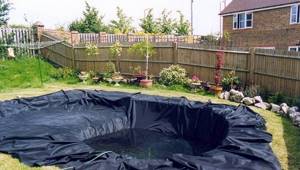
Among the advantages of the film, we note its environmental friendliness and high resistance to biologically aggressive factors. It is also characterized by high tensile strength, elasticity, and an excellent coefficient of friction, which makes it easier to use in the process of waterproofing the bottom, as well as coastal slopes. The material is characterized by complete tightness (due to a two-layer membrane and high density). In addition, one can note its frost resistance, immunity to the influence of the root system, and sufficient resistance to chemical influences.
The disadvantages are a short service life (about 10 years), an increased level of humidity during interaction with soils.
Butyl rubber film . This is a two-layer waterproof material 1 mm thick with elasticity reaching four hundred percent, which is based on synthetic rubber. The service life of butyl rubber is about 50 years.
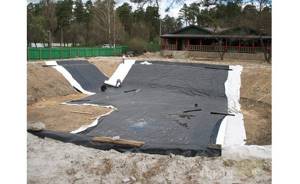
Butyl rubber belongs to a new generation of materials, characterized by the following properties:
- high resistance to tears and punctures;
- ease of installation;
- resistance to various weather and atmospheric phenomena;
- ease of repair of individual areas;
- safety for all living organisms;
- Possibility of application to any surface;
- membrane width reaching 60 m;
- the ability to give the pond any desired shape, as well as the ability to change it if desired;
- a wide range of component materials, due to which it is possible to give greater density to the areas where pumps, corners, etc. will be located;
- service life is up to 50 years, which means that the high cost of the material itself is fully paid off due to the period of its use.
Butyl rubber does not have any significant disadvantages.
Decorative film , consisting of polyvinyl chloride, covered with waterproof glue with gravel of different sizes.
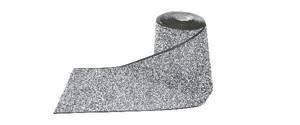
The main advantage is the decorative effect, which creates the illusion of a bottom covered with sand and stones. Such a film will help with the design of the entrance to the reservoir, in creating an imitation of a dry riverbed, and giving the banks a more natural look. The gravel itself can be small or large, imitating pebbles.
The disadvantages of decorative film are similar to those of PVC film, since this is its basis.
Geotextile is a rolled material 4 mm thick, with a density of 400 g/m2. This type of waterproofing is used in the construction of a pond as a base for the film, ensuring its better preservation and greater sealing density. To decorate the banks of an artificial reservoir, you can also use coconut mats, which help to better compact the soil and simplify planting.
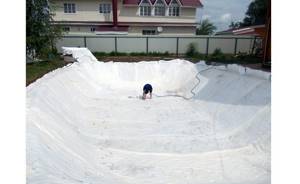
Superdom
Pond planning
Before you start building a pond, decide what you need it for. A decorative
pond, a fish pond or a family swimming pool will require different materials, technologies and means.
It is worth thinking about whether there is enough space on the site and where it is located. If the garden is small or located on a slope, the optimal solution is a pond raised above the ground . This option is also suitable if the groundwater level is too high and the drainage system cannot be expanded. Classic in-depth ponds are possible where there is enough space, good drainage and no large trees growing nearby.
The dimensions of the future reservoir are determined depending on its purpose. The minimum area for a bath should be 5-7 m2, and the depth 80-150 cm, for a decorative pond - 3.5-5 m2 and 60-120 cm, respectively, and for a pond with fish - 7-10 m2 and 150-170 cm .
It is important to provide for the following points: free access to the pond and additional equipment, a place to rest, what plants you are going to use to decorate the pond or what fish to put there. When planning, the location of additional elements is also taken into account - lighting, fountain, waterfall, stream.

raised pond
A mini-garden, a summer aquarium for fish, a watering tank - all this is a raised pond. Usually its height does not exceed 60 cm. Such a reservoir is built from ordinary brick
,
concrete
blocks, ready-made containers or wood.
The inside is lined with a waterproofing film, painted with water-repellent paint or plastered with waterproofing mixtures. The outside is decorated with whatever your heart desires and your imagination dictates. A hole must be left at the bottom for draining or pumping water into the cleaning system .
If it is not possible to purchase treatment equipment, water is released through drainage pipes and collected using a garden hose. Advantages . Easy to maintain: its shallow depth makes it easy to clean it, plant new plants, and thin out thickets. Can be placed in any corner of the garden and even on the terrace. Flaws . Excessive fluctuations in water temperature during the day and from season to season. For the winter, plants and fish will have to be moved indoors. The need for cleaning equipment or a high-quality water drainage system.
Ponds using flexible waterproofing
With flexible insulation
you can create a pond of any shape, depth and size. The only requirement is a perfectly cleaned earthen base. A hard material must be placed on it to protect the film from tearing. The choice of flexible materials is quite wide.
A small pond can be made from low-density polyethylene . It is stronger than usual and can last up to 5 years. But even the best polyethylene cannot compare with special pond films, which, nevertheless, require a protective backing. Polyvinyl chloride film will serve faithfully from 10 to 20 years, and butyl rubber, the most reliable and durable material of all film coatings, will last up to 50.
If you are planning to create a liner pond, do not forget that it needs a filtration
, and this equipment costs a lot.
Advantages . Can be of any shape and size. Durable. Withstands temperatures from –50 to +50 °C. You can build it yourself. Wide price range. Flaws . They are afraid of poorly prepared foundations and plant roots. Need protection from wild animals and rodents. Expensive biofilters are required for normal functioning.
How to determine the required dimensions and film thickness?
Add two depths and another 80 cm to the length of the pond, 2 depths to the width and another 80 cm to decorate the banks. Second option: add length and width to triple the depth. For ponds with an area of up to 5 m2 and a depth of no more than 80 cm, material with a thickness of 0.5–1 mm is used. With a depth of 1 m and an area of more than 15 m2, a film of 1.2 to 2 mm is required.

Concrete ponds
This is a complex engineering structure, so saving on the project, materials and services of qualified specialists does not make sense. Professionals say that sometimes it is easier to build a new concrete pond than to correct defects in an already built one. If something is calculated and done incorrectly, it is impossible to correct the error without time-consuming and expensive work.
In a pond made of concrete, you can equip a bathhouse, a fish pond, a decorative water window of any size, supplement it with a fountain, stream, cascade, waterfall, but in any case, the pond will be equipped with a filtration system and bottom drainage.
Advantages . They serve up to 80 years. Multifunctional. Can be of any shape and size. The banks can be decorated with sculptures and bridges. Flaws . Expensive. Duration and labor intensity of construction. The impossibility of rebuilding and eliminating breakdowns without costly and dirty work.
Clay pond
The best choice if the garden is planned in a natural style : artificial materials here will look alien. Such a reservoir can be of any shape and size, but must have an additional coastal lock for drainage. A very popular idea is to build a pond from two bowls, one of which serves as a swimming pool, and the other as a garden of aquatic plants and at the same time a natural water purifier.
The first base layer is made of clay-crushed stone mortar with a layer of 10–15 cm. Then geotextiles are laid, followed by pond rubber, and a plaster mesh on top of it along the edges. Pebbles, for example, are placed on top of the mesh so that the pond looks as natural as possible.
Advantages . Multifunctionality. Can be of any shape. Environmental friendliness. Cheapness. Resistance to seasonal temperature fluctuations. Flaws .
Labor-intensive work on equipment.
Construction of a pond from film: step-by-step instructions
Having decided on the location and approximate size of the future pond, you can begin to think about the necessary materials that will allow you to build a pond at your dacha in a short time and with a minimum amount of effort.
If you want to acquire a capital and expensive pond structure, then you will need to build a concrete foundation, for which formwork is first erected and reinforcement is performed. Less finance, time and effort is required when arranging an artificial reservoir using a ready-made plastic container.
The most convenient and budget option for building a pond with your own hands can be called laying out the bowl of the reservoir with a special moisture-resistant film. Let's talk about this method in more detail.
Step 1 . First of all, you will need a plan of your future pond, observing the scale, as well as indicating the depth and width of the shelves intended for planting. In addition to the plan, it wouldn’t hurt to have a rough sketch of how to decorate the pond.
Having an idea about the decor of your pond will help you avoid various alterations, both during the construction process and when planting plants. At this stage, decide what will primarily attract attention in the composition of your pond; perhaps you will use an original stone, wood or sculpture as an accent.
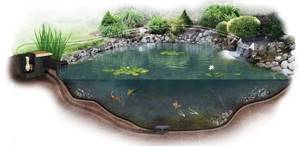
Step 2 . Using a regular water hose or sand scattered around the perimeter of the future pond, mark the expected contours of the reservoir. Make sure that its entire coastline is at the same level.
When forming a pit, also measure the height of the banks from time to time. If you do not have a water level of the required length, you can use an ordinary long board with a fifty-centimeter mark installed on it.
Step 3 . At this stage, the construction of a pond at the dacha involves excavation work. First, a pit is dug for the coastal tier and the depth line is marked, after which the depth of the pond increases. Having made a pit for the second tier, the burial line is again marked, after which the deepest part of the pond is dug out.
The process of forming a pit is quite labor-intensive, so the optimal solution would be to contact excavation specialists who work with a mini-excavator.
If you are determined to handle this part of pond construction yourself, keep in mind that water will accumulate at the bottom of the pit, which means you will have to work in dirty slurry. To pump out liquid, you can use a pump specially designed to remove water containing impurities and solids. By digging an auxiliary pit near the main pit, you can use it to dump liquid mud.
Step 4 . Having completely formed the pit, take the cord and begin measuring its dimensions, including depth. You need to add about 50 cm to the resulting dimensions, after which you can go shopping for the film of the required size. In the process of digging a pit, you will probably be faced with the question of what to do with the earth formed as a result of the work. In principle, there are different ways to solve this problem, starting with uniformly raising the level of the site and ending with using it as a base for an alpine slide.
Step 5 . At this stage of construction, the pond bowl is covered with a durable moisture-resistant film. To increase its strength, as well as to protect it from possible damage from stones or plant roots, it is better to lay it on top of a layer of geotextile. Instead of the latter, you can use old linoleum or roofing felt, or simply fill and compact sand at the bottom of the pit.
To make the film more elastic, laying it should be done on a sunny day; due to slight heating, it will stretch better, easily bypassing the existing protrusions of the pit.
Step 6 . It is necessary to lay an auxiliary trench along the entire perimeter of the reservoir - it is necessary for tucking and securing the film. Its edges are laid in a trench, after which it is covered with crushed stone. Reliable fixation in this case is guaranteed.
Step 7 . To prevent soil from falling from the banks into the bowl of the reservoir, strengthen the shoreline with stone blocks or plastic pipes nailed to pegs. To decorate the edge, you can use natural stones, beautiful single blocks or groups of boulders.
Step 8 . At this stage, building a pond with your own hands involves placing prepared plants in special containers and placing them on the designated areas, decorating the bottom of the reservoir with stones and rubble.
Step 9: Now is the time to fill your pond with water. To make it easier in the future to select pumping equipment and determine the volume of hydrochemistry required in the process of caring for the pond, take readings from the water meters before and after filling the reservoir.
Step 10 . To prevent stagnation of water, arrange a stream through which the liquid will constantly circulate. For this purpose, it is necessary to raise the source of the stream above the level of the pond; a submersible pump will help ensure the supply of water to it from the bowl of the pond.
Artificial ponds in the garden plot (with photo)

A pond in the garden is a great pleasure, but also a considerable responsibility. After all, building and decorating an artificial pond, even the simplest and most unpretentious one, with your own hands is a lot of work and a great desire to bring beauty to your site.
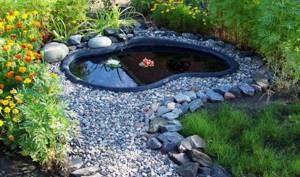
Of course, it’s easier to shift such work onto someone else’s shoulders, but, firstly, it is very expensive, and secondly, no one except the owner himself can do everything with great love, accuracy and to his liking.
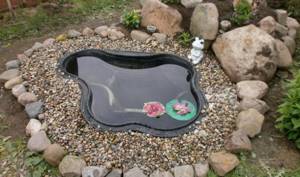
And if you choose the most suitable option for constructing a pond at your summer cottage within your means and strengths, then the desired result will certainly be achieved. Moreover, any decorative additions to the design of the reservoir can not be made immediately, but as needed.

Almost all artificial ponds in summer cottages are built according to approximately the same scheme. Some can be buried in the ground, others can be left on the surface; the pond can be large or small, of any shape and design style.
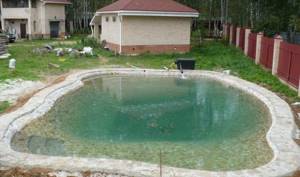
Unlike a pool, it is not necessary to dig a very deep pit for a pond, and it also does not require enhanced thermal protection and a durable bowl design, unless you plan to combine a decorative pond and a swimming pond in one project.
As you can see in the photo, the pond on the site can be anything - it all depends on your desire:

The main thing is to prepare correctly: determine the purpose of the reservoir, choose its location, shape and size, as well as the decorative style. After this, you can prepare and purchase the required material and begin work.
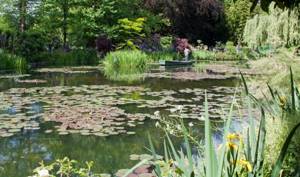
Since, unlike swimming pools, the water in ponds does not need to be subjected to special treatment (chlorination, ozonation, etc.), they require the creation of a certain biological balance. Otherwise, the water in the pond will bloom, become cloudy, the plants will begin to wither, and it will be favored only by midges and frogs - this is a very dubious pleasure for the owner of the pond.

It is better to start construction work in the summer or spring, when the groundwater “subsides,” which will significantly simplify the work.

Initially, you need to create a project that would take into account all the nuances of a personal mini-water area, how the size and shape of the pond will be combined. It is necessary that the landscape near the house looks holistically, it is also necessary to determine what the volume of work will be and how much materials will be required.
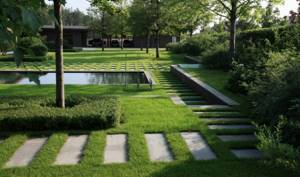
Sometimes even a small, but carefully designed pond requires significant effort, time and money than a large, but easy-to-build pond.
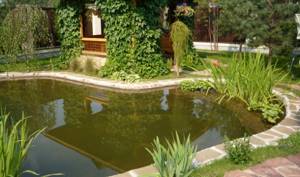
Before you decide on the type of reservoir, you need to become more familiar with its possible shapes, sizes, structure, design, as well as what materials will be required.
Look at the photo: ponds in a garden plot vary in shape, size, materials used to create the reservoir bowl, and design style:
Filtration and decoration of the constructed pond
If you decide to build a pond at your dacha, you will definitely have to take care of installing a filter station. It becomes especially relevant if you are breeding fish in a reservoir. Filtration kits can be purchased at specialty stores. Thanks to the available instructions, you can easily cope with their installation and configuration.
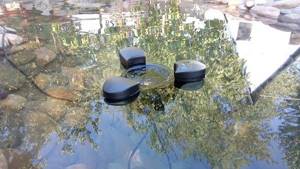
Once the filtration equipment is running, you can begin planting. The first deep level can be decorated with a tail or arrowhead. Floating plants, such as lilies, water hyacinths and others, will also look good. You can decorate the space around the pond using ferns, reeds or reeds.
For any summer cottage, an artificial pond will be the main decoration. In addition to plants, you can use stones, figurines, interesting figures, and small trees to decorate a pond. Such elements will help you create a unique composition.
To decorate the bottom of the reservoir, use only round stones that do not have sharp corners. To camouflage the edges, you can plant the shoreline with broadleaf plants. If desired, illumination of the pond can be provided in advance, for which electrical wiring is installed at the stage of forming the pit.
Definition of the word "pond"
According to the wording of the dictionaries, a pond is a body of water in an artificial or natural depression with a small water surface area, created for a specific purpose and purpose. It is used for breeding fish and waterfowl, irrigation, recreational activities, or for some aesthetic reasons. It is worth noting that this definition of a pond also includes a dammed place in the river, usually abundant with fish.
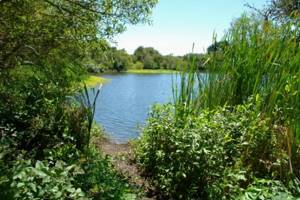
If in the original plan ponds were built near populated areas only due to the lack of natural reservoirs, then later they were created regardless of this. Today, artificial ponds are increasingly a tribute to fashion and are located on private property and summer cottages.
Typical mistakes that occur during pond construction
When creating something with your own hands, various mistakes are sometimes made, including compositional ones.
You can avoid them by familiarizing yourself in advance with the most typical mistakes made during the construction of ponds and reservoirs:
- If you decorate the banks of a reservoir with pellets of the same diameter, then it will look rather boring. The best option would be to alternate large and small stones, and you should not place them throughout the coastal zone of the pond.
- The depth of the pond is too great and the walls of the pond are almost vertical, making it look like a kind of earthen sack. Earthmoving companies are interested in digging deep pits, since payment for their work depends on the number of cubic meters of earth removed. Approach the depth of your pond responsibly; do not deepen it too much, especially if you do not intend to use it for fish farming.
- Typical mistakes include the craving for container gardening, which interferes with the normal development of plants, as well as the fear of filling the pond with soil for planting. In principle, there is nothing criminal in such planting; on the contrary, its advantages include the ability to quickly change the plant design by rearranging or rearranging plants.
Most gardeners are likely afraid of ending up with a dirty pond after filling with soil. However, this fear is unfounded, since a heavy mixture containing a large amount of clay is used as soil for aquatic plants, which is not washed away by water, but is strengthened over time due to the root system of the plants.
When you plan to build a pond with your own hands, remember that this process is quite labor-intensive, and therefore you can form a miniature pond at home as a training exercise.
Rules for caring for a constructed pond
- In summer.
After the construction of the pond is completed, water is released into it, fish are stocked, algae are planted, it is time to think about the proper care of this aquatic kingdom. Fish need regular feeding, but it is important to avoid overfeeding. Vegetation must be periodically thinned or replanted.
If the summer is hot, the water level in the pond may decrease due to natural evaporation. A decline of 3–5 cm is normal. However, a more significant decrease in water level indicates the need to replenish the reservoir. This can be done simply by using a hose, but keep in mind that the well water may be too cold.
For pond inhabitants, temperature changes can become quite painful. If there are water lilies in the pond, do not direct a stream of water at their location, since the rapid movement of liquid and the contact of drops on them will negatively affect their ability to flower.
Among the nuances of summer reservoir maintenance, we note one more. Due to heavy rainfall, layers of fertile soil may be washed into the pond, causing the pond to bloom. To prevent this phenomenon, it is necessary to install high-quality drainage. If the pond does bloom, then perhaps the drainage system needs adjustment.
- In autumn.
Autumn is the most problematic time of year in caring for an artificial pond. The main difficulty is the leaves falling into the pond, which must be removed from it as quickly as possible. Otherwise, they will sink to the bottom, decomposing there and poisoning the water with decay products. This is fraught not only with a specific odor, but also with danger for waterfowl and aquatic plants.

The greatest danger to artificial reservoirs is willow. However, today you can cope with the problem by using convenient and effective protective nets stretched over the surface of the water. In this case, the leaves will fall on them without causing any worries to the owners of the pond.
It is also necessary to promptly remove wilting aquatic plants from the pond, even if they grow in hard-to-reach places. To do this, you should use special underwater pruners. On warm autumn days, you can replant algae, and before the onset of cold weather, species that are not resistant to frost must be removed indoors. Stems protruding above the surface of the water must be trimmed to prevent pests from infesting them.
- In winter.
Leaving the inhabitants of the reservoir in the same place or relocating them depends on the size of the pond. If the reservoir is large, then they can spend the winter in it without any problems, you just need to take care of their safety.
Before freezing, the water is sufficiently saturated with oxygen. However, rotting plants remaining at the bottom of the pond will become a source of swamp gas that can kill all the fish. In this regard, be sure to leave wormwood in winter to allow harmful gases to escape and oxygen to enter.
If your pond has a concrete thicket, then there is a risk of its destruction under ice pressure. Sloping the walls during pond construction somewhat reduces this risk, but it is best to completely drain the water from the pond before frost sets in.
- In the spring.
After the snow melts, the pond needs to be thoroughly cleaned of the waste products of its inhabitants located at the bottom. It is best to transplant the plants and fish into a temporary pond or other reservoir at this time. In this case, you can easily drain the water, thoroughly clean the pond, and, if necessary, repair any damage that has occurred.
Keep in mind that at the beginning of spring, plants and fish may be quite weakened. When the air temperature rises to +8...+10 °C, you can diversify the fish diet with protein food. For more active algae growth, it is worth using special fertilizers. Waterfowl inhabitants of the reservoir should be examined for diseases. If the fish show signs of disease, they must be isolated, otherwise the infection may spread.

- Cleaning.
After finishing the construction of the pond, do not forget that the reservoir needs to be cleaned approximately twice a year.
There are several ways to clean ponds:
- Mechanical - involves the use of forceps, scissors, nets, as well as additional filters.
- Chemical – performed by adding special preparations to water. Due to these additives, the acidity of the water is restored, ammonia and harmful metals are removed from it, and the liquid is saturated with oxygen.
- Exposure to ultraviolet lamps is harmful to microalgae, bacteria and viruses.
- The popular method is to place a bag of peat in water.
The water in the reservoir must be renewed periodically. However, this does not mean completely draining the pond, as this poses a danger to its inhabitants. At one time, approximately 15% of the total volume is usually replaced. If you are building a large pond that does not drain for the winter, once every three years it still needs to be emptied and the water bowl cleaned.
By adhering to these recommendations, you will enjoy the purity of your pond, its beautiful flora and fauna.
[edit] Fish catcher
Fish catcher
- this is a short channel up to 4 m long and 1.5 m wide, located at the outlet pipe (bed) of the drainage behind the dam. A lintel is made on it into a tongue and groove with grooves for the gratings. After draining the water from the pond, when it remains only in the channel, the grates are inserted into the channel and the grate is removed from the drainage outlet. The fish with residual water freely passes into the fish catcher, from where it is easily caught with nets or nets. A fish catcher is constructed to facilitate the catching of fish and to protect it from injuries that can be caused by fishing gear.
Approximate cost of pond construction
In most cases, the estimate does not include the cost of the contractor’s visit to the site, the purpose of which is to determine the scope of work, as well as to draw up a project for the construction of a decorative pond.
Basically, the minimum area of ponds is 500 m2 (if the future pond is smaller, then detailed construction instructions are given or the cost is discussed separately). Travel to the regions is carried out at a negotiated price.
| № | Name | Unit change | Price | Note |
| 1 | Installation of a protective layer of geotextile 350 g/m2 | m2 | 25% of the cost of geotextiles for turnkey installation. 15% for installation supervision | |
| 2 | Waterproofing a pond using Firestone film | m2 | 25% of the cost of the film for turnkey installation. 15% for installation supervision | |
| 3 | Installation of equipment (pumps, filters, lighting) | m2 | 35% of the cost of equipment | |
| 4 | Construction of a reservoir, turnkey pond | m2 | From 2500 | The cost of constructing artificial ponds depends on the size of the reservoir; discounts are possible for large volumes. The price for constructing reservoirs depends on the selected shoreline material. The cost of constructing a pond depends on the complexity of the terrain. |
| 5 | Planting customer's plants | PC. | From 250 |
Connection with other words
Words containing -pond-:
- dam
- jurisprudence
Words starting with pond-:
- prudence
- Prudkovskaya
- Prudkovskaya
- Prudkovsky
- Prudkovskaya
- pond
- pond
- pond
- pond
Hypo-hyperonymic relationships
body of water pond
What is a pond like (adjectives)?
Selection of adjectives for words based on the Russian language.
clean small small large patriarchal mill fish external quiet artificial frozen deep round dark mirror black old monastery huge overgrown turtle small main standing dirty wide forest duck decorative silver green calm frog blue picturesque shallow city village maiden abandoned whole muddy swan vast nearby transparent swampy cold new dried other real sacred neighboring millet rotten square oval bottom notorious tiny ice shadow sparkling
What can a pond do? What can you do with the pond (verbs)?
Selection of verbs for words based on the Russian language.
wither up appear to be standing swim freeze catch dry seem constitute sit turn overgrown reflect rise remind become dry cover have lie hear pond appear shine live stay freeze look breed clear shallow settle down disappear fall heard swallow smoke sit down drown sparkle seethe appear flow glow calm grow sparkle accept spill drown overflow splash whistle stall rise belong evaporate flow out begin rise up come out see fall
Associations to the word pond
lily duck swan fish water lotus carp fountain center garden park fish water lily shore house breeding end forest drainage mill foot boat lowland river edge departure waterfall evening trout island fishing rod road frog search side city dam suburb middle shadow algae direction crucian carp cinema Moscow stone window castle hour of September mountain hope field guide bush bathing island rock fishing abbey grove escort bath garden
Hypernyms for pond
- water
Scope of use of the word pond
Ecology Technology General vocabulary Proverb Gold mining
